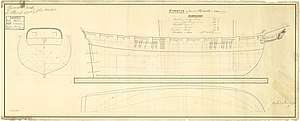HMS Eugenie (1797)
 Plan showing the body plan with stern board outline and some decoration detail, sheer lines with inboard detail and figurehead, and long longitudinal half-breadth for Eugenie. Signed by John Marshall [Master Shipwright, Plymouth Dockyard, 1795-1801].National Maritime Museum | |
| History | |
|---|---|
| Name: | Nouvelle Eugénie |
| Builder: | Nantes |
| Launched: | 1797[1] |
| Captured: | 1797 |
| Name: | Eugenie |
| Acquired: | 1797 by capture |
| Fate: | Sold 1803 |
| General characteristics [1] | |
| Tons burthen: | 24126⁄94 (bm) |
| Length: |
|
| Beam: | 13 ft 6 in (4.1 m) |
| Depth of hold: | 26 ft 2 in (8.0 m) |
| Sail plan: | Brig |
| Complement: |
|
| Armament: |
|
HMS Eugenie (or Eugenia) was the French privateer Nouvelle Eugénie, launched at Nantes in 1797 that the British Royal Navy captured in 1797 and took into service. As a brig-sloop she served in the Channel, primarily escorting convoys, and was sold in 1803.
Privateer
Nouvelle Eugénie was built between 1796-1797 and was commissioned in 1797 under Joachim Barbier.[2]
On a cruise in March 1797 she captured Spencer, which was carrying a cargo of coffee, sugar, and cotton from the West Indies, and sent her into Lorient.[3][4]
On 11 May, Indefatigable in company with Phoebe (1795), Cleopatra, Childers, and the hired armed lugger Duke of York captured Nouvelle Eugénie. She was a razee privateer of 16 guns and carried a crew of 120 men. She was four days out of Nantes on a 30-day cruise, but had taken no prizes.[5] The Royal Navy took her into service as HMS Eugenie.
Royal Navy
Between 9 August and 27 November 1797 Eugenie was at Plymouth undergoing fitting. Part of the work involved changing her from a ship rig to a brig. Commander Philip Somerville commissioned her in October for The Downs.[1]
On 9 April 1799 Eugenie captured Welvaart Van Pillau.[6]
Eugenie was in company with the hired armed cutter Flirt on 11 May 1799 when they re-captured the brigs Betsey, of Liverpool, and the Four Sisters, of Sunderland.[7] Eugenie also recaptured the Danish galliott Tre Sostre or Drie Gezusters.[8]
Eugenie. and the hired armed cutters Nox and Ann were in company on 23 May when Ann captured the four-gun privateer lugger Aimable Therese.[Note 1]
Lloyd's List reported on 7 April 1801 that Eugenie had recaptured the brig Juno, Wallace, master. A French privateer had captured Juno near Dungeness as Juno was sailing from Lynn to Penzance. Eugenie sent Juno into Dover. The same privateer had captured a brig carrying corn and sent her into France.[10] Juno was a small, two-year old coasting brig of 72 tons (bm).[11]
In August Eugenie sustained casualties while participating in Lord Nelson's unsuccessful raids on Boulogne. She suffered three seamen killed and one officer and five seamen wounded.[12]
On 26 November the Swedish East Indiaman Sophia Magdalena ran onshore near Kingsdown on the South Foreland. Eugenie and HMS Anacreon came as close as they could and rendered assistance.[13]
In May 1802 Commander Fasham Roby replaced Somerville.[1]
Fate
The "Principal Officers and Commissioners of His Majesty's Navy" offered the "Eugenie sloop, 241 tons", lying at Deptford for sale on 1 December 1802.[14] Mr. Freake finally purchased her on 3 January 1803.[1]
Notes, citations, and references
Notes
Citations
- 1 2 3 4 5 Winfield (2008), p.287.
- ↑ Demerliac (2004), n°2259, p. 260.
- ↑ Crowhurst (1989), p.119.
- ↑ Lloyd's List №2917.
- ↑ "No. 14010". The London Gazette. 16 May 1797. p. 447.
- ↑ "No. 15588". The London Gazette. 28 May 1803. p. 641.
- ↑ "No. 15162". The London Gazette. 23 July 1799.
- ↑ "No. 15171". The London Gazette. 20 August 1799. p. 842.
- ↑ "No. 17110". The London Gazette. 13 February 1816. p. 289.
- ↑ Lloyd's List №4140.
- ↑ Register of Shipping (1802), Seq.№J943.
- ↑ "No. 15397". The London Gazette. 15 August 1801. p. 1005.
- ↑ Grocott (1998), pp.120-1.
- ↑ "No. 15532". The London Gazette. 13 November 1802. p. 1196.
References
- Demerliac, Alain (2004). La Marine de la Révolution: Nomenclature des Navires Français de 1792 A 1799 (in French). Éditions Ancre. ISBN 2-906381-24-1.
- Crowhurst, Patrick (1989) The French War on Trade: Privateering 1793-1815. (Scholar Press). ISBN 0859678040
- Grocott, Terence (1997). Shipwrecks of the Revolutionary & Napoleonic Eras. London: Chatham. ISBN 1861760302.
- Winfield, Rif (2008). British Warships in the Age of Sail 1793–1817: Design, Construction, Careers and Fates. Seaforth Publishing. ISBN 1-86176-246-1.